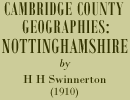< Previous | Contents | Next >
23. Roll of Honour.
Situated as it is on the direct and easiest route from the south to Scotland, and possessed of many attractions of its own, Nottinghamshire was often visited by the early kings, especially by John and Richard III, with whom the castle was a favourite residence. It was from here that the latter went forth to Bosworth Field. The former died in the companion castle at Newark. Edward I frequently visited the county on his way to and from his wars in Scotland. It was during one of these visits that his beloved Queen Eleanor died at Harby.
Southwell with its cathedral was situated at the southernmost point in the province of the Archbishop of York. Consequently the great ecclesiastics often occupied the beautiful palace here. The most noted amongst them was Cardinal Wolsey, who retired to this place after his downfall.
The county has produced several archbishops. Chief amongst them was Archbishop Cranmer, who was born and spent his boyhood at Aslockton. The first bishop of the newly-created (1884) bishopric of Southwell was Dr Ridding.
William Brewster, the leader of that Puritan band who ultimately sailed in the Mayflower, was for a long time a resident and postmaster at Scrooby.
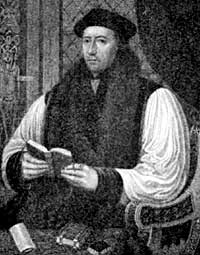
Archbishop Cramner.
The village of Cromwell gave its name to a famous family. One of them, Ralph, Lord Treasurer under Henry VI,was intimately associated with the county. This was not the case with Thomas Cromwell, the minister of Henry VIII, and Oliver Cromwell, both of whom were distinguished members of that family.
Of prominent Parliamentarians, Denzil, Lord Holles, was born at Haughton near to Retford. It was he who on one occasion held the Speaker in his chair whilst the House passed resolutions against the unjust taxes and religious innovations of Charles I. He was also one of the five whom the King accused of treason. John Evelyn Denison, Speaker of the House of Commons (1857-72),was born at Ossington.
Colonel Hutchinson, who held Nottingham Castle during the Civil War, and General Ireton, Cromwell’s son-in-law, were both well-known names in the county. The former came from Owthorpe and the latter was born at Attenborough.
With the village of Langar are associated two great families—the Scropes and the Howes. A stately memorial to Admiral Earl Howe, who distinguished himself in the wars with France, stands in St Paul’s Cathedral, but his remains lie peacefully in the village church of his ancestral home.
Several famous Elizabethan sailors hailed from this county, notable among them Sir Hugh Willoughby, who attempted to find a north-east passage to China and perished with all his companions in the attempt. He sprang from a distinguished family at Willoughby on the Wolds, which now for many generations has resided at Wollaton Hall. Sir Martin Frobisher, explorer of the north-west passage, belonged strictly to Yorkshire, but he owned the manor of Finningley. He was accompanied on several occasions by Edward Fenton, who came from the hamlet of Fenton, near Sturton.
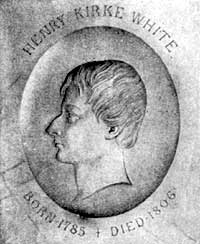
Memorial to Kirke White in Wilford Church.
The men of Nottinghamshire have also served their well by their inventions. By inventing the frame the Rev. William Lee of Calverton be-father of the hosiery industry. John Heathcoat a machine for making bobbin net, and thus lace industry for Nottingham. The great cotton industry is mainly dependent upon two machines, the spinning-frame and the power-loom. The former was invented by Sir Richard Arkwright, whose first mill, driven by horses, was set up in Hockley, in Nottingham. The latter was invented in 1784 by Edmund Cartwright, a member of a well-known family which resided at Marnham. Mechanical ingenuity was not his only gift for he was a divine of no mean order, a great scholar, and somewhat of a poet. Of the same spacious type of mind was Dr Erasmus Darwin of Elston Hall, “poet, physician, philosopher, philanthropist,” and grandfather of Charles Darwin. He also attempted to devise various mechanical contrivances, for example “an organ which should pronounce the Lord’s Prayer, the Creed, and the Ten Commandments.”
Marshall Hall, a physician renowned for his researches on the nervous system, was born in Basford and practised in Nottingham.
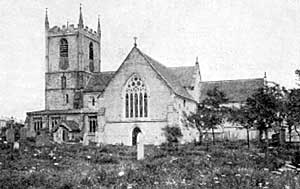
St Mary's, Hucknall Torkard (Byron's burial place).
For centuries the name Byron shone in connection with this county. It died out in sunset splendour with the poet. Several years of his youth were spent at Southwell. For the next few Newstead Abbey was his home. He died at Missolonghi in Greece in 1824,and his body was brought to England and interred in the family vault in Hucknall Torkard church. Of lesser poets Henry Kirke White was born the son of a Nottingham butcher and died at twenty-one, and Philip James Bailey, the author of Festus, was a native of Nottingham. The well-known writers William and Mary Howitt, though not natives of the county, lived many years of their busy literary life in Nottingham. The county historian, Thoroton, belonged to the village of Car Colston.
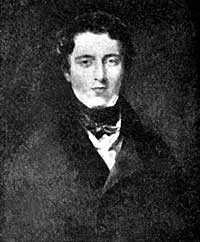
Richard Parkes Bonington.
In the domain of Art there is one name which stands out pre-eminent. Richard Parkes Bonington, who was born October 25, 1802 at Arnold, son of the Governor of Nottingham prison, had but a short life, for he died in 1828, but he attained the very highest excellence both as a water-colourist and as a painter in oils, and year by year the appreciation of his genius gathers strength. At Nottingham, in 1725,was born Paul Sandby, the father of English water-colour painting, and four years previously his less-known brother Thomas.
